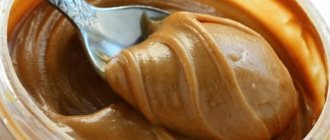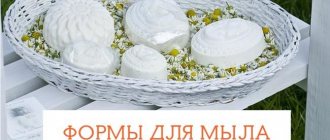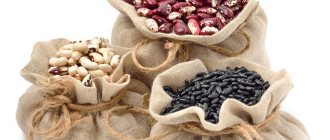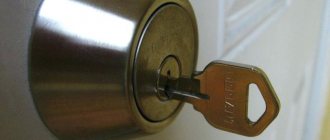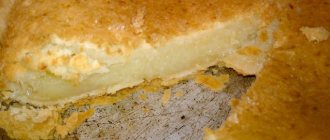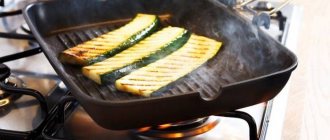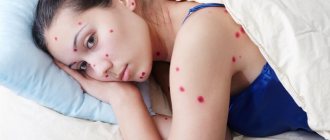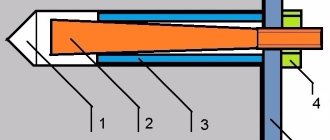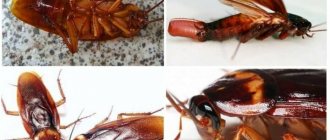Even the most delicious and aromatic cake can fall apart when removed from the mold. To prevent this nuisance from spoiling your tea party, take your time, choose containers made from modern non-stick materials, and use secret techniques. These tips will help the housewife remove the sponge cake from a silicone or glass mold quickly and without damage.
Split forms
Housewives use springform molds to assemble cheesecakes, mousse desserts and other sweets without baking. They allow you to give all layers of the cake a clear structure. Keep the dish in the refrigerator so that the sand layer and cream harden. Do not rush, otherwise the layers will spread across the dish when removing the sides.
To assemble the dessert correctly, place the springform directly on the serving plate to avoid transferring the cake from the board and risking its structure.
Follow the recommendations in the recipe, take your time, act carefully, and then your culinary masterpiece will not suffer. And in the event of a break, impregnations and fillings will always save you.
What can you soak a biscuit with?
Coffee syrup is ideal for soaking
chocolate
biscuits
and cupcakes. Simply add 2 tablespoons of freshly brewed coffee to the cooled sugar syrup. For fruit cakes with white sponge, citrus syrup works great. Add the zest of half a lemon or orange to the cooled sugar syrup.
Interesting materials:
What is better compact or pene? What is better: a quartz lamp or a bactericidal lamp? What is better: Swan's down or sheep's wool? Which is better, linoleum or? What is better megabyte or megabit? What is better: microwave or electric oven? What is better for flooring: linoleum or laminate? What is better: natural fluff or artificial fluff? Which is better to plaster or plasterboard? What is better for glazed or glued tiles?
What to do if baked goods stick to the pan
The dough should actually stick. This way it rises more evenly and does not swell with a hump in the middle of the form. But tearing pieces of baked goods off the coating every time is also not an option, so you can use:
- French shirt. Both butter and vegetable oil will do. To ensure that the dough can still cling to the sides of the pan, sprinkle the fat with flour, and then turn the pan over to remove the excess. But in general, I do not recommend this method due to the negative effect of oil on the edges of the cakes. It's better to use others.
- Parchment paper. It is glued to the mold with a thin layer of oil. All that remains is to pour and bake the dough. It is better to choose more expensive siliconized paper. You don't have to pick it out of the cakes. Some varieties are even reusable.
- Silicone or Teflon mat. The best option, which at the moment is not so expensive. Silicone and Teflon are easily separated from baked goods, wash without problems, and do not require lubrication with fats.
If you want the cake or cupcake not to stick to the metal pan at all, even without grease, then take a closer look at how you cook. Most likely, one of the classic errors is occurring:
- Poorly washed uniform. Often, due to adhering fat and pieces of dough, baked goods can even stick to the non-stick coating. Remember to thoroughly wash and degrease the baking sheets after use.
- Error in recipe. Maybe you didn’t beat the eggs enough for the sponge cake, or you arbitrarily reduced the amount of sugar, salt, butter, flour or other ingredients. Try to follow all the advice, including regarding the beating speed and mixture temperature.
- Temperature too high. It's possible that the dough has time to burn to the pan while you're trying to bake the middle. Reduce the temperature to the recipe's specifications and recheck the oven with a food thermometer.
- Didn't bake much. If you try to remove the dough too quickly, it may stick to the pan. First, make sure that the pie or crust is well baked. Also remember to let the baked goods cool before removing them from the pan.
I'm sure that once you solve these problems, the dough will simply stop sticking. Or at least the desserts will be much easier to separate from the mold without damaging them.
I talk about cupcakes, pies and biscuits all the time, but what baked goods stick with you most often? Maybe this is not a dessert at all, but something else, like lasagna, cubete? Please tell us in the comments.
Old Growth: find mold samples and defeat mold-1 • Eurogamer.net
What's worse than black mold?
Old Growth is a side mission in Control that you can start after completing the threshold.
Emily Pope will ask you to find Dr. Underhill from her college, who is studying the mold growing under the Research Center. This will take you to the hidden underground world of the Research Sector.
Here you will find the Pit and former Bureau employees who have been infected by the fungus. It looks like Hiss has some competition when it comes to invading the Bureau of Control.
On this page:
Need more help finding your oldest home? Then check out our Control walkthrough hub with links to all of our Control guides.
How to Start Controlling Old Growth
You can start Old Growth by talking to Emily Pope in the boardroom in Central Executive after you've started My Brother's Keeper.
Before you begin this mission, make sure you have unlocked the levitation ability by defeating Salvador in My Brother's Keeper.
Find Dr. Underhill under the Central Research Facility
Emily Pope will ask you to find her friend, Dr. Underhill. Apparently she was studying the mold growing throughout the Old House.
To find her, you need to go to the Central Research Center using the sector elevator or post, passing through the checkpoints.
In any case, go to the lowest floor of the Central Research Facility. Look for black plants growing near electric lights. In the corner near this plant you will find a hole.
Jump down into the pit, using your levitation ability to land safely.
Welcome to the Pit.
Head into the next room and use the Launch ability to place the electrical box in the socket next to the door you just came through. This will reactivate the elevator, allowing you to easily enter and exit the pit.
:: 20 Best Xbox One Games You Can Play Right Now
Once you do this, go through the door into the next room.
You can find a chest on a small ledge to your right.
Go through the Level 4 door and talk to Dr. Underhill.
Items found:
- Research and Records - Research - Control Account for Threshold Utility
- (On the table behind the doctor. Underhill's laboratory.)
- (On the cart on the right side of Dr. Underhill's lab)
- (On the table to the left of Dr. Underhill's laboratory)
Collectible locations are Threshold Utility Counteressay, Underhill: Checking In, and Mold Threshold.
Collect five sample molds for Doctor.Underhill
Dr. Underhill will ask you to find five different mold samples. Go through the door on the right, go up the stairs and go through the door to go further into the Pit.
Follow the hallway all the way to the right, going down the stairs to find a chest and a collectible.
Going through another doorway will take you to the main room of the Pit.
Kill the first two fungus-infected people you encounter and you'll end up on a plateau overlooking the Pit.
The pit is a very dangerous place, so it is better to destroy the enemies before moving on. To do this, stay on the plateau.
There are two more fungus-infected people in the lower right corner of the house, but the creatures you want to focus your firepower on are the living fungi. They will spit poison at you, leaving you dead after four or five shots depending on your health.
The best way to kill them is to shoot them with your service weapon and raise your shield when you see the purple poison coming towards you. If you haven't unlocked your shield yet, complete the "Good Defense" mission.
There are four of these living mushrooms in total. Each looks like a thinner version of people infected with the fungus.
Whatever you do, don't touch the purple floor.
The best order to search for samples is:
- Type E
- Type D
- Clear checkpoint
- Type A
- Type B
- Type C
Items found:
- Case Files - Modified Items - Pink Flamingo DLC
- (At the bottom of the hallway on the right before you enter the main room of the Pit.)
Collectible Location - Pink Flamingo DLC
How to find the pit control point
After you have made the Pit semi-safe. Go up to the stairs directly opposite the plateau you're standing on.
Climb the stairs and go through the doorway to find a Checkpoint.
Clear it and you can quickly descend into the Pit whenever you want.
Where to find Type A: grows near fresh corpses
In the room with the Control Point, go behind the pillar and you will find a small room containing a Type A.
If you're in trouble, follow the corpses.
Type A location.
Where to find Type B: Grows near toilets
In the far left corner of the main chamber of the Pit you will see a hole with a sign about a toilet next to it.
Go through this hole and you will find yourself in what used to be a bathroom. In the left corner you will find all the toilets grouped together.
Climb up this toilet block and you will see Type B growing out of the toilet.
Climb the toilet block to reach Type B.
Where to find Type C: Grows near TVs
After collecting Type B, go further along the corridor from the former bathroom.
Continue past the desk and up the stairs until you find a doorway labeled "Lab 05".
Enter this lab and you'll find a sample growing in front of the TV.
Go through the door to Lab 05 to find Type C.
Where to find Type D: grows near stairs
Go to the stairs just beyond the plateau and you will enter. You will find Type D under the stairs.
There is a chest nearby.
Type D location.
Where to find Type E: Grows near the Pit
Drop down to the table directly below where you first enter the Pit to find this specimen.
Type E location.
Talk to Dr. Underhill
Once you have collected all the samples, take them to Dr. Underhill.
She will give you a mystery pill and tell you to investigate the source of the mold.
Explore the pit
Return to the main Pit room and go down through the Pit in the center of the room. It's a huge hole in the floor with purple smoke coming out of it.
Kill the two mushrooms you encounter. You can also access the chest and collect it by knocking down the pile of rubble hiding the doorway. This will lead to a small office area where you can fly up to a ledge to find the chest.
Heading left will take you to a pit. Continue down the hallway to find a chest, killing the fungus-infected people you come across. Follow the hallway to the left and you'll come to another hallway that appears to have roots growing out of it.
Go along the corridor and kill the mushrooms you find there.
Grab the chest in the corner next to all the dummies before jumping into the hole to fight Mold-1.
Items found:
- Multimedia - FBC Records - Threshold Log 1
- (On the floor when descending to the lowest level of the Pit.)
- (In the room you first enter at the bottom of the pit, knock down the rumble to your right to open the doorway, then go up to the top level and take it off the table.)
- (On the floor in the room before the battle with Mold-1.)
Collectible Locations - Threshold Journal 1, Balloons Addition, and Threshold Journal 2.
How to defeat Mold-1 in Control
Before you fight Mold-1, make sure you have the best Headshot Boost mod for your chosen weapon form. You'll be aiming directly at Mold-1's head, so this will give you an advantage over the creature.
Levitating into the pit will take you to Mold-1's house.
Wait until Mold-1's health bar appears at the bottom of the screen, because any damage you deal to Mold-1 before then will not count.
Mold-1 attacks you by spitting poison bullets and throwing one of its arms at you. You can avoid these attacks by hovering around the room or hiding behind one of the large blocks.
The best way to attack Mold-1 is to alternate between using your launch abilities and then striking with your service weapon. Aim for the middle, largest head of Mold-1 to deal the most damage. You'll also want to try and launch as many of the mushroom balls hanging from the ceiling in Mold-1 as possible, as they will deal extra damage.
There is a way to kill Mold-1 without taking damage. When you enter Mold-1's room, you will land behind a large cuboid. If you move to the right - to the point where you can attack Mold-1 but will still be partially hidden by the block - Mold-1 will not attack you. This will allow you to simply kill Mold-1 without taking damage.
Try to stand here to avoid being attacked by Mold-1.
Return to Underhill
After you kill Mold-1, go through the doorway at the back of the house. If you can't find him, he's surprisingly well hidden, just run around the edge of the room.
This is the doorway you need.
Go through this doorway and clear the checkpoint you find. There is also a chest and a collectible in this room.
Use the checkpoint to quickly return to the Central Research Facility, then return to Dr. Underhill the same way you found her.
Talk to Dr. Underhill and she will be less than happy that you killed Mold-1.
Collectibles to find:
- Multimedia - FBC Posts - Threshold 3
- (In a dark corner in the room with the Control Point after Mold-1.)
Collectible Location - Threshold 3.
It's time to head to the mysterious Federal Bureau of Control. Our Control walkthrough can help you complete story missions, including "Welcome to the Oldest House", "Unknown Caller", "Director's Override", "Old Boy's Club", "The Threshold", "My Brother's Keeper", "The Face" Enemy", "Finnish Tango", "North Star" and "Take Control". You can also learn new supernatural abilities by completing Happy Pursuit, Good Defense, and Captive Audience. We also have guides on upgrading your service weapon, your abilities, how to use weapons and personal modifications, how to unlock each outfit, and solving the roulette wheel puzzle.
Rewards for completing Old Growth
Completing Old Growth will start the Mold Removal side quest. You will also be rewarded with:
- 4 ability points
- 1 Material
- 1 mod. Weapons
.
How to Remove Mold and Mildew from Anything and Everything
Mold and mildew thrive in damp conditions. This means that musty-smelling mold can be found on damp clothing just as easily as it can be found on carpets and upholstered furniture. (Ugh!)
To avoid this situation, TODAY Home asked some cleaning professionals what the best way to deal with mold is.
Here's how to remove mold and mildew from...
... white cotton clothes
Olivia Joyce, a cleaning professional with Move Out Mates, has two effective ways to combat mold, depending on the fabric. ,
Bleach is the most effective way to remove mold and mildew from clothes made from white cotton, says Joyce. Apply a solution of one part bleach to three parts water to the stain and leave the solution for a few minutes, then wash it as usual.
... non-marking clothes
Trending stories, celebrity news and the best of TODAY.
If the item cannot be bleached, try removing the mildew with lemon juice or white vinegar. Soak a cotton pad in lemon juice or vinegar and apply it to the stain. Let it soak in for a few minutes. Remove the pad and sprinkle the area with a little salt to enhance the effect of the acid. If possible, place the item in a sunny place to dry. Sunlight also whitens stains. Repeat if necessary, then wash as usual.
If the mildew stain persists, take the item to a professional dry cleaner.
...mortar and walls
To effectively remove mold and mildew from walls and grout, Joyce suggests mixing a solution of one part bleach and three parts water. Wet (do not soak) a sponge in the solution and apply it to the moldy areas. (Be sure to wear protective gear like goggles, gloves and even a face mask, advises Joyce.) Once the mold is gone, dry the affected area with an old towel. The mold itself isn't that hard to clean, but it can get dirty if you don't squeeze out the excess water from the sponge.
...upholstery
Jack White, vice president of technical services at Rainbow International, explains what's really happening when you see mold on your comfy couch.
Mold must have the right conditions to grow on upholstery. First, there must be an organic food source—mold cannot grow on synthetic materials, but it can grow on soil contained in synthetic materials. (A good excuse to vacuum your furniture!) There should also be humidity. Organic material must remain moist for a certain period of time for mold to begin to grow. (Before replacing cushions, make sure any spills are wiped up and the fabric is completely dry.)
With that knowledge in mind, here are White's recommendations for dealing with mold on upholstery:
- If your upholstered furniture is water damaged and has a significant amount of mold growth it should be replaced.
- If there is only a small spot of mold, you can try using a 3 percent hydrogen peroxide solution. Blot the mold and let it sit for about a minute. Rinse the affected area with the solution, alternately wiping it with a damp cloth or sponge and a dry cotton cloth. This probably won't remove the mold, but it will help reduce the stain.
- Consult a professional upholstery cleaner if the stain persists or reappears.
White also indicates that silk, wool, antique or vintage upholstery should be cleaned by a professional.
… carpet
Be wary of mold, says carpet cleaning expert Dean Carter. Silk and wool rugs should always be professionally cleaned. Likewise, only a certified mold expert should remove any significant amount of mold from your carpet. However, if it is a very small area and it is safe to use chlorine bleach on the carpet, you can try this.
- “Don't use bleach without first testing an inconspicuous area of the carpet to make sure there is no color loss,” warns Carter. “You can get away with it on some carpets, but not others. Although some loss of color is still better than mold in the house.”
- If possible, clean the carpet using a steam cleaner. If you don't have access to a steam cleaner, scrub the moldy area with a sponge soaked in a mixture of 1 teaspoon liquid dish soap (I prefer Blue Dawn) and 1 liter of water.
- After initially cleaning the surface, mix 1 cup of household bleach (hypochlorite solution) with 1 gallon of water and sponge directly onto the affected area. Let the solution sit and soak into the carpet for 10 to 15 minutes.
- Use a steam cleaner (or professional vacuum cleaner) to remove any remaining moisture from the carpet.
- It is important to let your carpet dry for as long as possible to prevent mold growth. To absorb any residual moisture, cover the wet area with a folded towel and stand on it. Move the towel to the fresh area as the moisture will be absorbed. Be sure to wash the towel thoroughly after using it.
This story was originally published Jan. 24, 2022.
.
Why does the dough stick?
There are several reasons for the problem of baked goods sticking:
- dough is too thin;
- consistency is not viscous enough;
- the pie did not have time to bake;
- the walls were burnt;
- incorrect oven temperature;
- the form was not oiled or lined.
This is why it is important to follow the recipe. By adjusting the types and quantities of products, baking time and temperature, you can easily get an unpleasant surprise.
Mistake #6: Incorrect temperature
Perhaps the most important thing in preparing this simple pie. Charlotte should be placed in an oven heated to 140 degrees. The cake should set, and then you gradually raise the temperature. And finish baking the charlotte at 180 degrees. Very often, housewives put the pie in an oven that is too hot. And it doesn’t bake inside, but starts to burn on top.
With the method that I described, the pie will bake for at least 40 minutes, more likely 50 minutes. But this depends on the size of the mold and the pie.
How to remove cupcakes, muffins and cupcakes
Usually the problem arises only among housewives who cannot get rid of metal molds, most often still Soviet. In this case, the first thing I would recommend is to throw them away and finally buy disposable paper cups. Better fortified. They hold their shape well and don't need a tray with indentations. It is enough to tear them apart while eating.
You can also safely use silicone. This is a cheap, reusable option. You can remove the cake from the silicone mold by simply turning it inside out. If this is a particularly delicate muffin, use a toothpick to carefully separate the edge and then slowly unroll the pan.
If for some reason you are using metal molds, then use the same tips as for a regular Soviet baking sheet. But given the small size and grooved surface, instead of a spatula you will have to do the surgical operation using a toothpick, a knitting needle or the blade of narrow thin scissors.
How to cut a sponge cake evenly into layers
And so, finally, sweating from exertion and drinking motherwort to calm down, we took out a beautiful, even, smooth biscuit from the bowl. It's time for another rather important procedure, so catch your breath, take a deep breath and exhale slowly.
Have you calmed down? Now let's start cutting the biscuit into cake layers. Stop, just don’t faint, composure, smart advice and some tools will allow you to do this quickly and efficiently. It’s worth mentioning right away that you need to cut the biscuit cold and under no circumstances hot. It will be generally ideal if it sits in the refrigerator for a couple of hours before the “operation”.
Cutting a cake with a string saw
To alleviate the suffering of the hostess, savvy enthusiasts invented such technology as a string saw. It's very simple to use. When adjusting the height of the string, you must set it to the required thickness of the cake.
On some models there are several strings at once in order to get the required number of shortcakes at a time.
The strings do not move, do not slip, are perfectly tensioned and cut amazingly, the main thing is to follow the rules of use.
- Set the desired height.
- We bring the saw to the biscuit on a smooth, flat surface.
- We cut into the baked goods and, making movements as if we were sawing a tree, cut it into several flat cakes.
That's it, now you can coat it with cream and decorate your confectionery delight.
Cutting the biscuit using a knife and a removable ring from the mold
If you are not the proud owner of such a miracle saw, then you can use a knife. For biscuits, they produce special cutters with a long blade, but in the absence of this unit, you can resort to using a device you have at home with the longest serrated blade possible. But this does not mean that you need to take your grandfather’s Cossack sword off the wall and wave it in the kitchen like an ataman; a bread file will do just fine.
- We place the biscuit on a dish that matches the width of the mold, under which we place several more flat plates, as a height regulator.
- Now we pass the ring from the mold through the cake. Because of the plates, the biscuit will protrude somewhat above the metal sides; if anything, you can also place plates under the dish to make the cake thicker, or, on the contrary, remove it if you want to get thin biscuits.
- Using a knife, we begin to cut the protruding part of the baked goods, moving it along the edge of the ring.
Now 1 layer of the future cake is ready. We do the same with the rest of the donut.
You can use special molds for cutting biscuits.
How to cut a biscuit with a thread
The thread is definitely thinner than any, even the sharpest knife, and thanks to this it allows you to make thinner cakes. There is only one condition: the strength of the thread must be excellent, so the best option would be fishing line, nylon or dental floss. We will also need toothpicks to create a level cut.
- We stick wooden sticks around the circle of the biscuit at the same height;
- From fishing line (thread) we make a wide loop, which we throw over the baked goods so that it rests on the skewers, like a lasso.
- By pulling the ends, we tighten the knot, and, plunging into the walls of the donut, the thread cuts it through in a horizontal plane.
You can also use thread to cut the shortcakes using the method with a mold ring and plates, only instead of a knife we will use a fishing line (thread) stretched with both hands and move it through the thickness of the biscuit in a horizontal plane, like a saw.
How to remove the crust for a roll
In order for your confectionery miracle to turn out perfect, you must first remove it correctly after cooking. Looking back a little, it is worth noting that such a biscuit layer must be baked on parchment.
- Now, when it has already completely baked and cooled for about 10 minutes in the oven turned off with the door open, it needs to be removed from the baking sheet, but not torn off the paper. Having coated the entire cake with jam, we begin to carefully wrap it into a roll, gradually separating it from the parchment layer.
However, rolls are often made with cream, which you certainly cannot apply to a hot cake. Then you can use the second method.
- Having turned the baking paper with the biscuit onto oiled loose parchment, we need to remove the baked sheet from the cake as carefully as possible, which we then roll into a roll and leave to cool (we are talking about the biscuit, not the paper). This is done so that after cooling and decorating with cream, our product can be rolled up without, so to speak, losses in the form of cracks and breaks.


